| Report Type | Full |
| Peak(s) |
Damavand - 18404 |
| Date Posted | 05/14/2018 |
| Date Climbed | 05/10/2018 |
| Author | mrgooseskin |
| "Undercover" in Iran - Climbing Damavand |
|---|
|
Damavand is a peakbagger’s peak. The mountain appears on numerous lists, most notably as a country highpoint (the 22nd highest in the world), an ultra prominent mountain (15,312 feet of prominence, the 12th highest in the world), one of the Volcanic Seven Summits, and boasts a high isolation (723 miles to the nearest highest land, the east summit Elbrus). These qualifications alone would make it highly attractive to any thirsty peakbagger, but there are more alluring aspects of this mountain. The physical beauty brought on by its pleasing conical shape is very inviting, as standing atop such a “classically shaped” mountain is very satisfying. For such a lofty summit, its ease of access is amazing...an easy 2 hour drive from the hectic metropolis of Tehran brings one to the trailhead. In addition to that, the mountain plays a large role in Persian folklore, the most famous of which describes Arash, a mythological archer, who climbed to the summit and shot an arrow into the distance, to demarcate the border of ancient Persia. Finally, Damavand was an attractive objective to me personally because of it’s semi-obscure locale due to one of my nationalities...unless you’ve been living under a rock, you probably have some idea of how frosty Iran-U.S. relations have been for quite some time. This icy relationship translates to scores of economic sanctions put upon the country, as well as travel restrictions to each of its respective citizens. Lucky for me, I have dual citizenship with Switzerland, so I was able to enter the country and play regular tourist, something an American citizen simply cannot do. The US State Department website lists Iran under the “Do Not Travel Here...No Seriously, DO NOT!” section, alongside countries like Syria, Iraq, Somalia, Central African Republic, and Afghanistan. Here is a quote from the stern laundry list of tips the State Department gives if you are foolish enough to ignore their plead and travel to Iran: “Draft a will and designate appropriate insurance beneficiaries and/or power of attorney”. LOL! A little dramatic, I think. If the list of travel warnings on the State Department's website could be compared to the Schedule I List of Controlled Substances, heroin, meth and cocaine would be Afghanistan, Somalia, and Iraq, and THC would be Iran. Even when I disclosed my American upbringing and citizenship to Iranians I met, nobody was in the least bit hostile or intimidating towards me. More than anything, they were just surprised. Granted, I only spent 6 days in the country and only traveled in well-developed areas frequented by foreigners, but the point is Iran is nowhere near as dangerous as the US State Department will lead you to believe. Anyway, my trip began with a red-eye flight from Stockholm to Doha, Qatar (6 hours), followed by a quick hop over the Persian Gulf into Tehran’s Imam Khomeini Airport (2 hours) where I arrived late morning on Monday. As a Swiss citizen, I was eligible to obtain a visa on arrival at this airport, so I made my way over to the immigration office after purchasing 14 days worth of health insurance from a guy in a booth ($14). After filling out a short form demanding information such as my occupation, father’s name, and lodging contact for my first night’s stay, I paid the hefty $75 visa fee, handed my passport to a one-handed man who was acting as a liaison between the foreigners applying for visas and the serious immigration controllers behind the glass, who were working diligently, scouring their computer monitors and making several time consuming phone calls per applicant. I waited for about 75 minutes, with growing worry that the guys behind the glass somehow would find out I was in fact an American citizen trying to gain access into their country. I breathed a sigh of relief when the one handed man called my name and told me to proceed to the passport stamper. Badda bing, stamp stamp, I was in Iran! The terminal had emptied since ours was the only flight that had arrived in the past couple hours, and only me and a few of the straggler foreigners applying for visas were left from our fight. I found a currency exchange booth and changed the 250 euros I had in cash with me to the local currency, Iran Rials (more on this confusing currency later). I made my way to the Metro train, which had just recently been completed to reach the airport. I was excited to catch the train just before it departed ($2, for the airport transfer, $ .2 for a regular ride in the city), for the next available train would not leave for another 80 minutes. As the train rolled away from the airport complex my excitement finally caught up with me in realizing where I was. The airport is located way beyond even the most fringe outskirts of Tehran, in the midst of beige, scrubby, flat terrain. The train was clean and empty, and I enjoyed the 30 minute or so trip through the empty landscape to the first station stop, where I was prompted to exit and board another train. The train continued underground so I couldn’t see my surroundings anymore, and with each stop, more and more passengers boarded the train. Within 5 or 6 stops, the train was packed wall to wall with men (separate compartments on either end of the train were reserved for women only), me squished awkwardly with my large pack in the corner, with perhaps a dozen salesmen walking up and down the train, proprietors of everything from gum and cigarettes, to electonic accessories, to children’s coloring books, and sandals. The vendors ranged from old men dressed in rags, to middle aged men dressed in strangely nice clothes, to boys as young as elementary age. From previous research I knew what station to exit the train to get to my hostel. I walked up the stairs on to the street and was met with immediate, deafening noise from the relentless traffic and mobs of people walking briskly by in all directions. The air was a suffocating mixture of diesel exhaust and dust, and with a temperature hovering in the upper 80s (which, coming from months of cool weather in Stockholm may as well have felt like 100 degrees), my throat immediately started choking up and felt tingly, unused to such air quality. I easily found my hostel where I checked in for one night ($15). After settling in, I set out into the jungle of Tehran to find supplies for Damavand. I knew of one outdoor gear store where I had hoped to find isobutane fuel canisters for my Jetboil. With all the economic sanctions and whatnot imposed on this country, I wasn’t exactly sure I’d be able to find anything compatible with my stove, but I found exactly what I was looking for the in the “Go Sport” store near the Sadr Subway station. I also bought a closed cell foam pad here. Two fuel canisters and the pad ran me about $30, and I was ticked off when I later found all these products in the Grand Bazaar after I got back from Damavand, for what surely would have cost a fraction of that price, but live and learn. 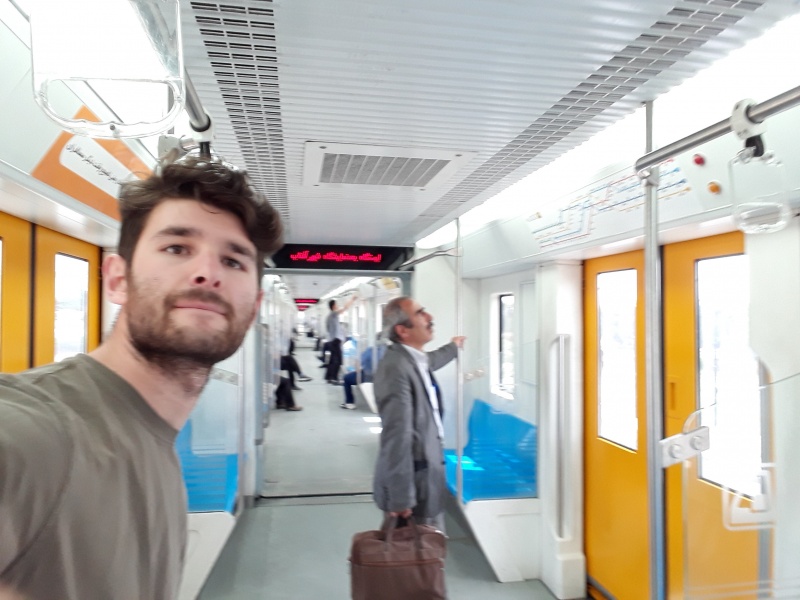 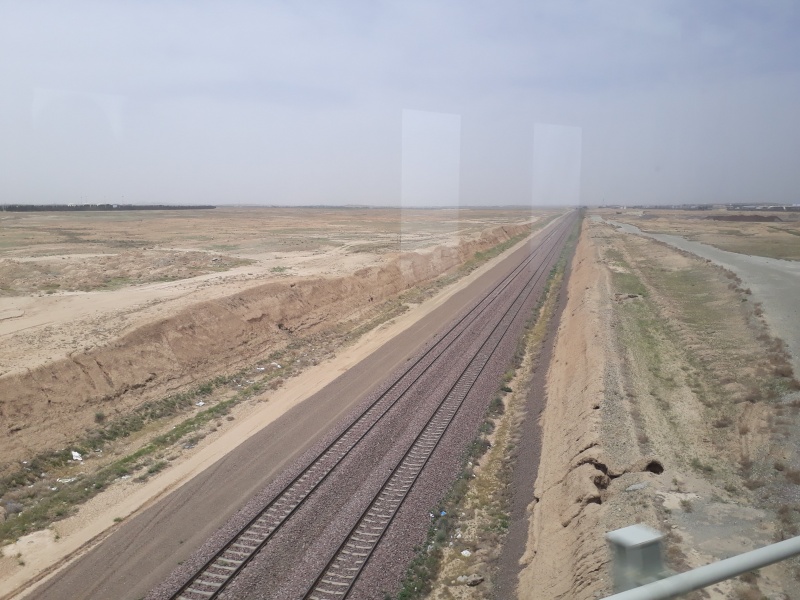  I spent the rest of the afternoon hunting down an Iranian SIM card (about $15 for one week with unlimited data...this turned out to be a worthwhile purchase) and buying food for my ascent. I returned to the hostel that evening armed with a good 15 pounds of pasta, veggies, potatoes, fruits, nuts, sweets, all for probably about $10. During this time I had to get used to the Tehran way of doing things, which basically amounts to being overly assertive within the crowd and pushing your way through to your destination, whether that is a subway train or a vendor’s counter. 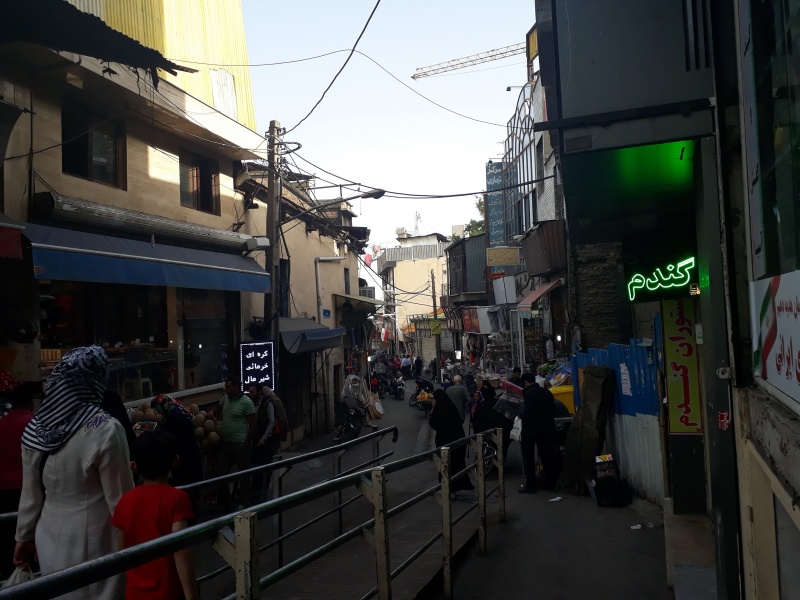 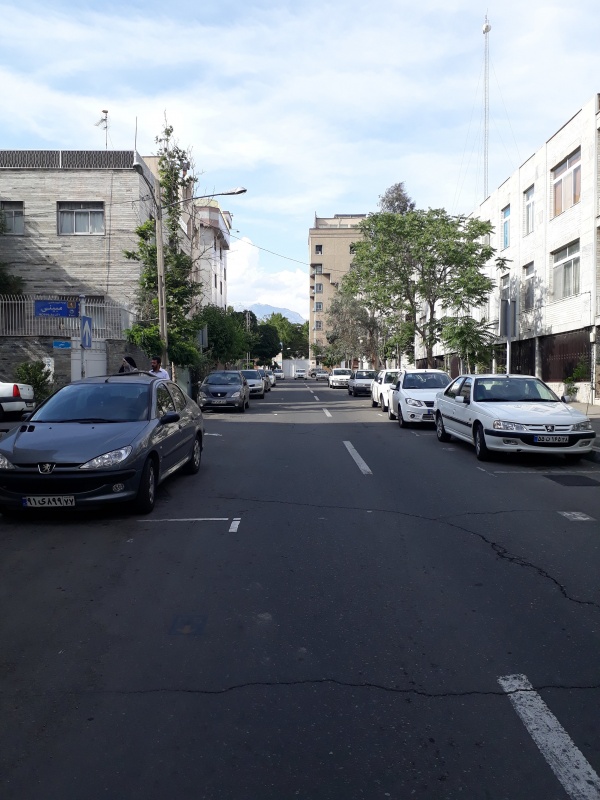 So, about the currency in Iran. The unit of currency is called the Rial (about 42,000 rials equals $1USD, give or take a few thousands). A popular way of expressing the price of things is in toman, which equals 1000 rials. So, something worth 100000 rials is also worth 100 toman. However, vendors could easily just say something like “10” to describe the price. Or they could just say the price in rials. Confused yet? I don’t think I ever figured it out in the 6 days I was there. To make things more complicated, Iran is not connected to the world bank network, so if you as a tourist run out of cash, you are SOL. I had to be extra vigilant in keeping tabs on about how much things cost (in rials...or did that guy charge in tomans last purchase?? ARGH) in order to monitor my cash reserve to make sure I was able to make it through my trip without running out.  Madness is the only word I can accurately use to describe Tehran. Crossing the street must have taken months off my life. The traffic does not stop, even for red lights or stopped traffic up ahead. People drive the wrong way. If you aren’t extremely vigilant, you will get plowed over. I quickly adapted to the method of mimicking a local to my side and just stepping out when they did, but even then it was a harrowing experience. By the time I reached the other side of the road I’d have the same feeling as when I’d finally reach the belay after a 2 hour long aid lead in the Fisher Towers. I was very excited to leave this madness behind and head into the mountains the following day. 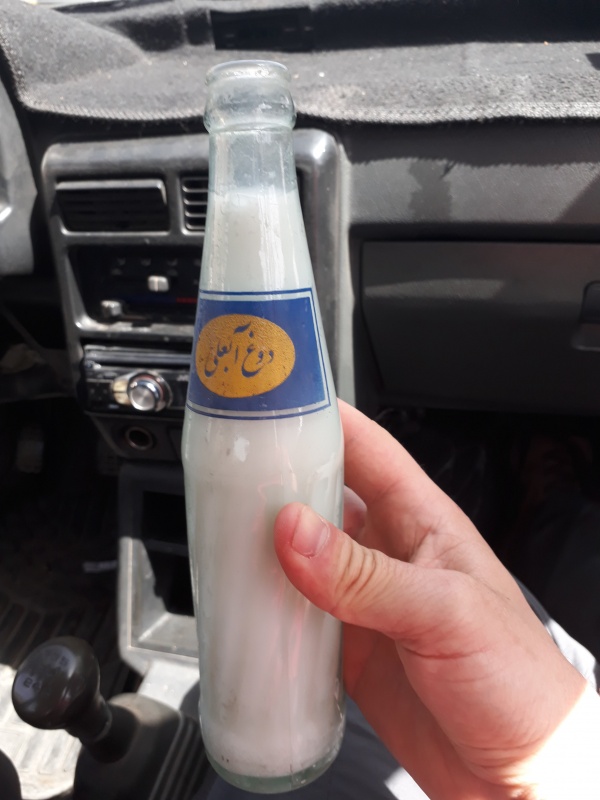 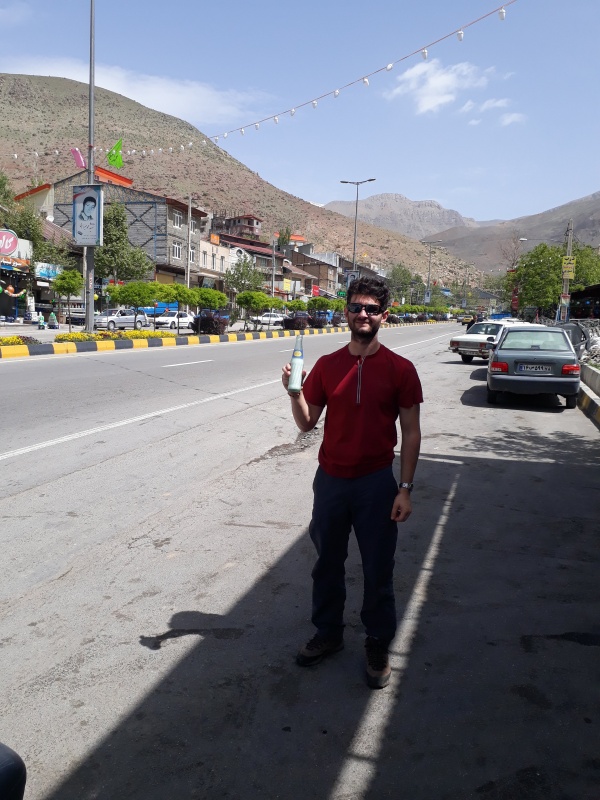 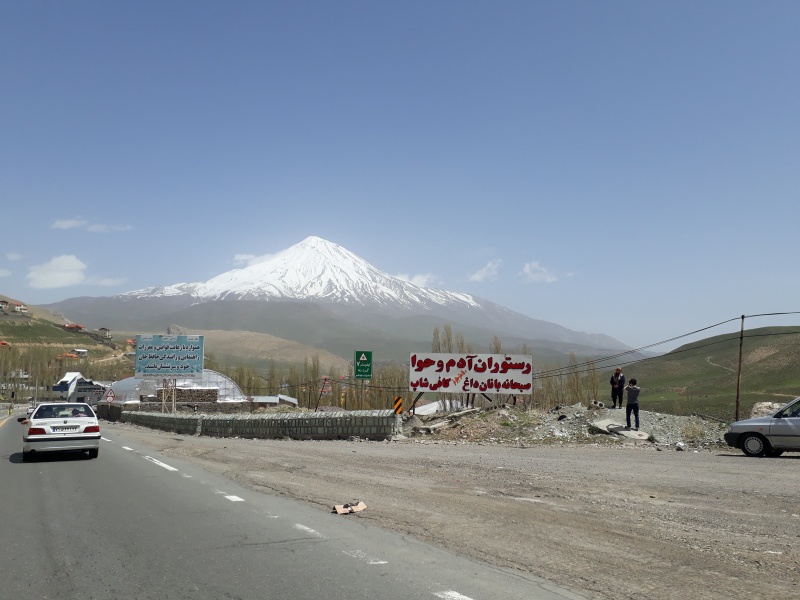 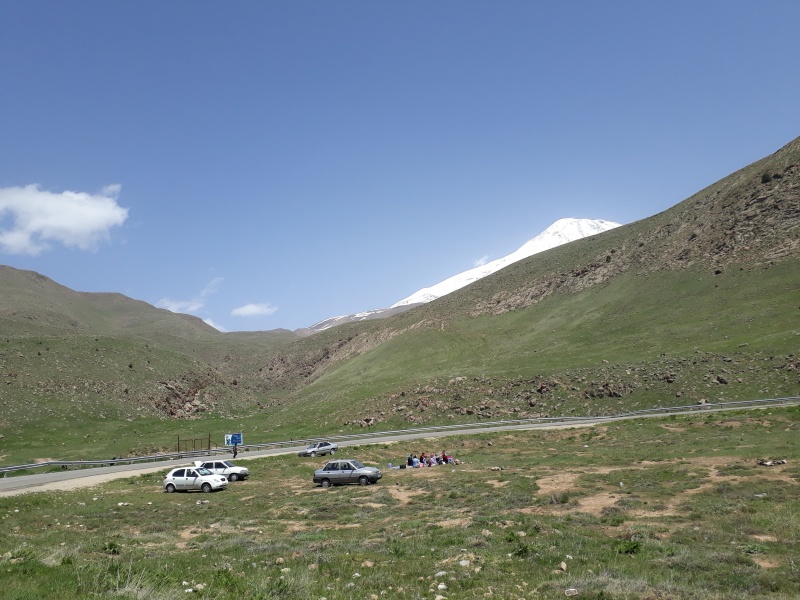 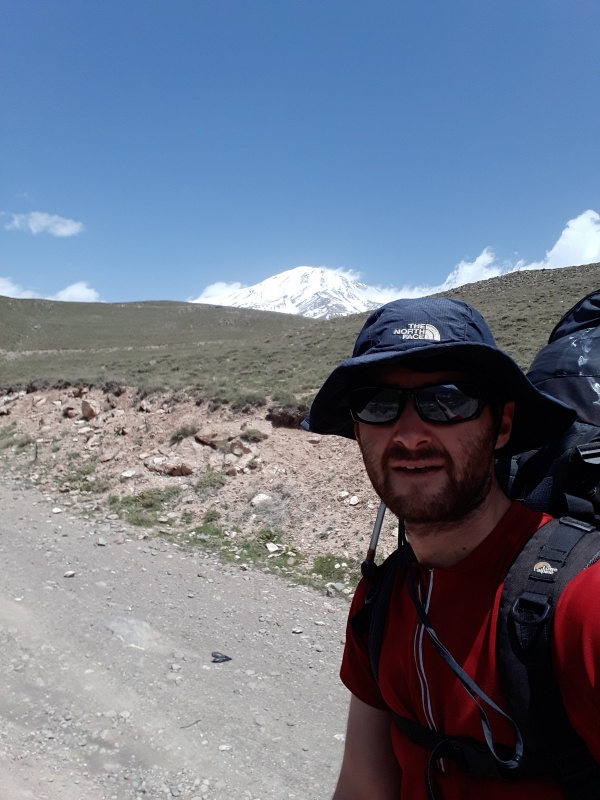 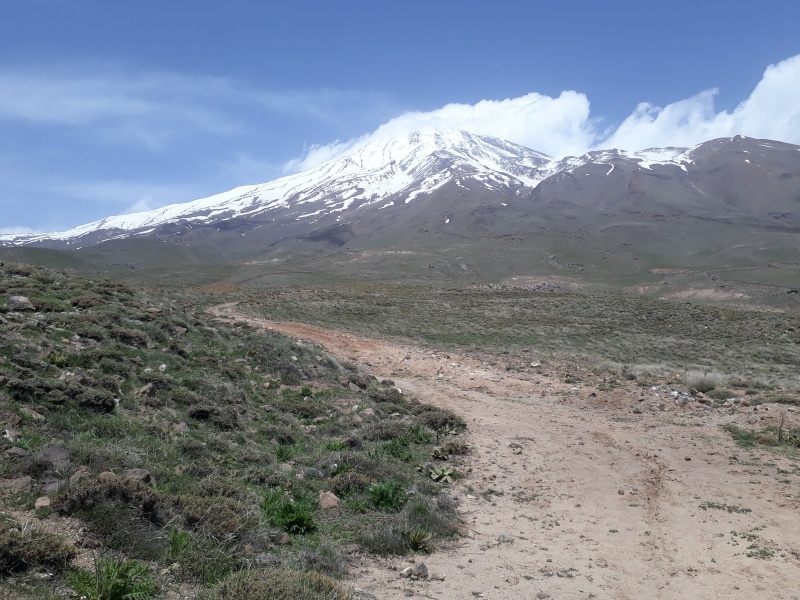 My hostel arranged a taxi for me to the trailhead for Damavand (about $25), a 2 hour long drive into the mountains east of the city all on good paved roads. In preparation for the upcoming increase in altitude, I was downing large bottles of water the entire car ride, my taxi driver amused with my constant requests for pee breaks on the side of the road. At one point my driver pulled over and bought me a glass of the most vile beverage I’ve ever drank, a popular, slightly fizzy sour curdled milk called doogh. I smiled diligently as I sipped it down, however the pure disgust I could hardly contain through my wincing face. I knew I was supposed to stop at the Iranian Mountaineers Federation building in the village of Polour to obtain my permit for climbing Damavand, but with it being off season, I took a gamble and decided not to do that, as I had read in previous reports that nobody ever checked to see it. At noon on Tuesday my driver dropped me off at the turnoff to the dirt road that leads up the lower section of the mountain at about 8000 feet. It was sunny and I could see all the way up the slopes of the peak to the windblown summit. There was a small parking lot with a couple guys offering to drive me up the dirt road in some battered 4WD vehicles for a few bucks, but I politely declined, for I was excited to finally be out of the city and was keen on simply walking out in the country. It took me about 2.5 hours to travel the 4 miles or so and 2000 feet of gain to my first overnight spot, a small mosque perched on a flat piece of land at 10000 feet. Though it was early in the day and I could have continued to the upper hut, I did want to take it really easy with the altitude. At first the sight of the surroundings of the mosque kind of put me off, as the place was kind of trashed and shabby, but soon after I settled inside and laid my stuff out, it became kind of cozy, and soon after a rain shower came through, the wind kicked up, and I became rather fond of my small domicile. I spent the evening taking small walks around camp, cooking food, and surfing the internet on my phone, as there was a little bit of 4g service here. The weather deteriorated outside but this made me even more cozy inside the mosque. I eventually fell asleep shortly after it got dark, enjoying being by myself after the madness of Tehran and listening to the pitter-patter of the rain drops on the mosque's tin sheet roof. 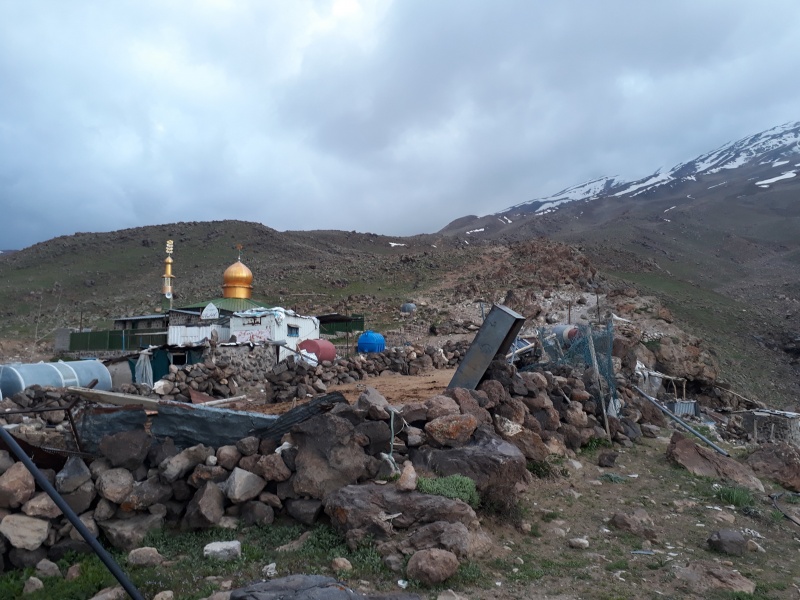 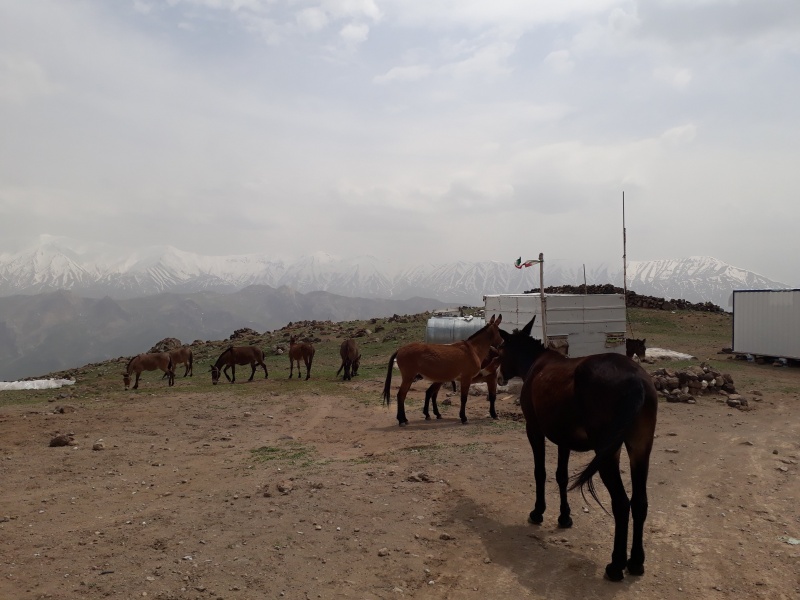 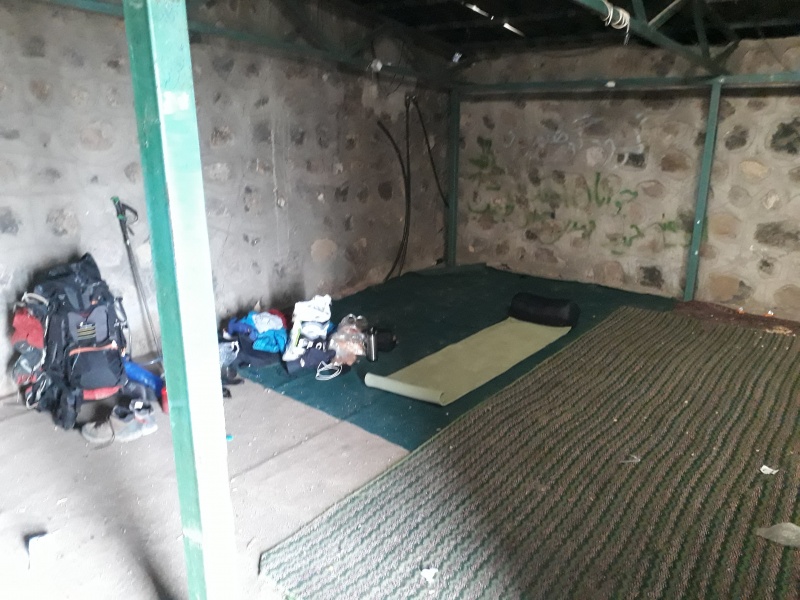 It was lightly raining went I woke on Wednesday. As I packed for the day, the first climbers I saw came by, a trio of French guys coming down from the upper hut, stymied by the bad weather on the upper mountain. I started out for the upper hut mid morning and hiked the wide trail up the gradually steepening slopes towards the hut. The fog line began at around 13,000 feet, and the final hour was spent hiking through the cloud and shin-deep snow. I reached the hut at 13,800 feet just as a light snow began to fall, 4.5 hours after leaving the mosque. Inside the hut I found two Austrian ski mountaineers, their Iranian guide who had claimed 150 Damavand summits, and the hut caretaker. The caretaker asked for my permit, that one I should have picked up down in Polour (oops). Luckily I was able to buy one from him, which equated to a whopping $50, by far the most expensive item I spent in Iran (other than the visa fee). I then paid my unexpected board for two nights in the hut ($7 total). I was very unprepared by being overprepared...due to the time of year I was expecting an empty hut with bare-bones accomodation, but instead I found a fully stocked food pantry with cheap prices on goods. It would have been better to forego buying food in Tehran, saving weight, and buying food at the hut, but training weight I guess? We spent the afternoon chatting, drinking tea, and cooking food, as the storm raged outside. With a weak cellular data connection, I was able to pull up weather forecasts on my phone which showed a clearing trend over the next 24 hours. We all went to bed with the intent of not waking up too early, as the forecast showed bad weather until about 8am. The storm raged all night, with howling winds battering the hut and heavy snow falling. 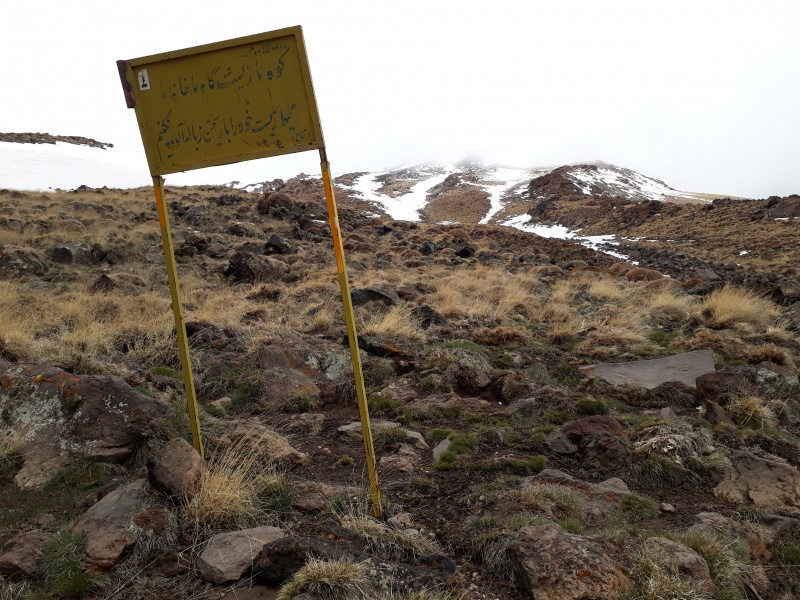 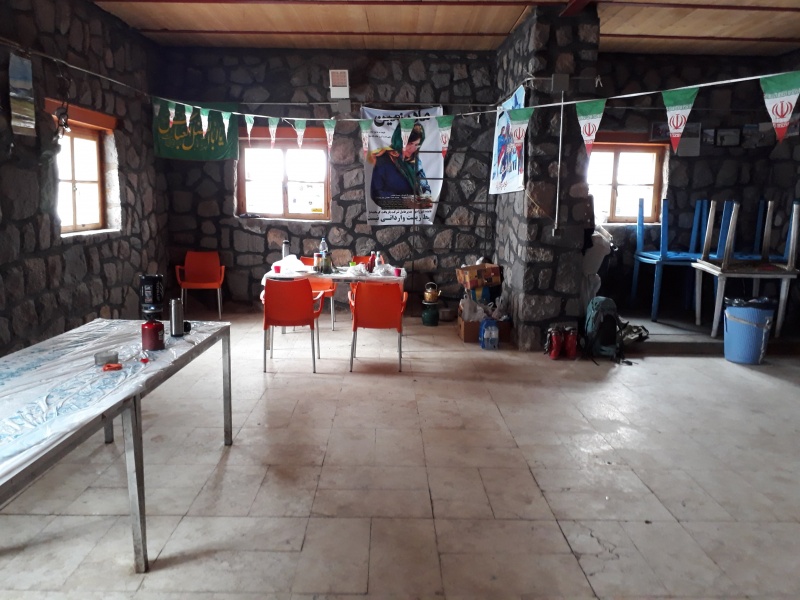 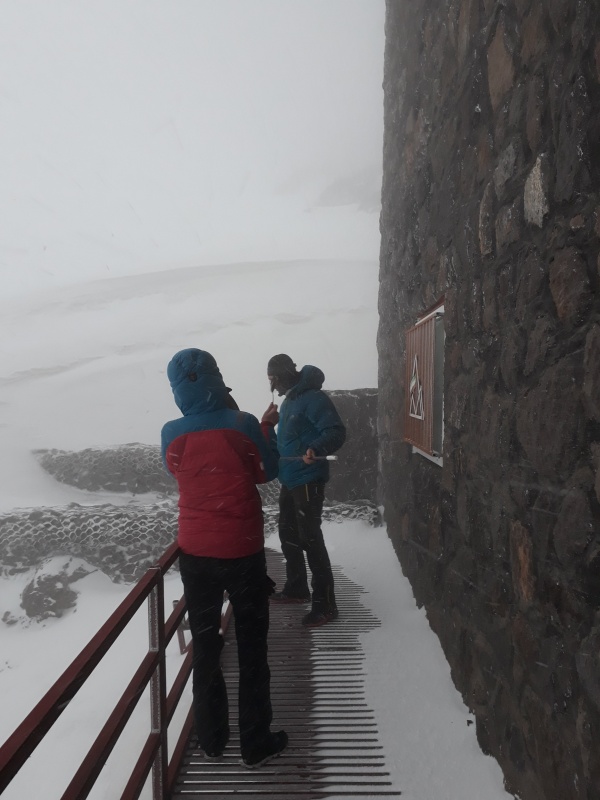  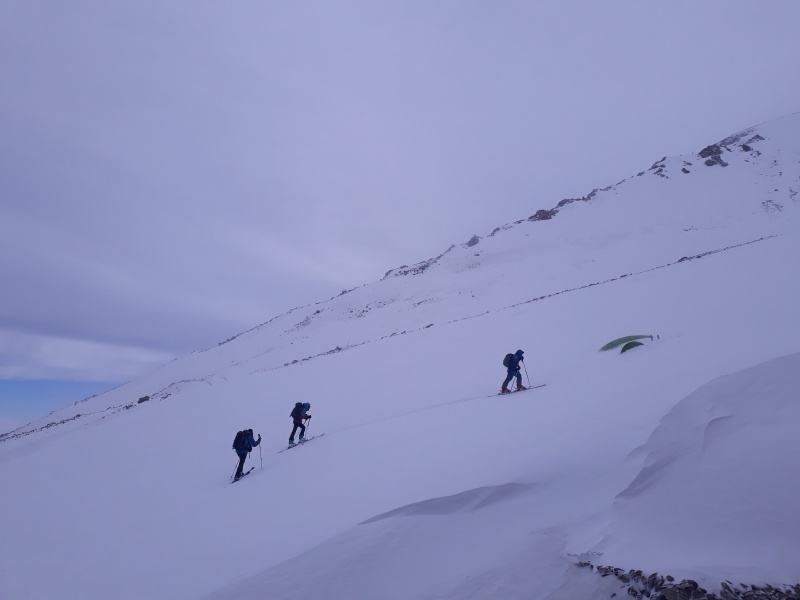 On Thursday morning the sky was overcast and there were moderate winds, but seeing as this was the Austrians only chance to summit, they and their guide set out at 9 am, skinning up from the hut. I had an intent to acclimate, and maybe or maybe not summit, depending on how I felt. I didn’t necessarily need to come off the mountain for another 3 days, so I could have afforded to wait. I popped some Advil, ate an orange, choked down a Clif Energy Gel and started out around 9:30. The 500 yards or so up from the hut are on mellow terrain, as the hut is located on a large bench on the south flank of the mountain. After this, the angle of the slope kicks back a bit, and after donning my crampons, I climbed firm snow straight up, with slight deviations here and there to avoid exposed talus. The route is very straightforward and clearly visible from the hut, however the scale of the mountain was really hard to gauge, for you could never really estimate how far you had gone or how much you had to go to get to the shoulder. The snow was not steep enough to warrant an axe, and I felt that two poles and crampons were perfect for the type of terrain. At around 16,500 feet I passed the Austrians, who had been switchbacking up the snow, as opposed to my straight-lining up. Their guide had just turned around, claiming something about a broken binding. The Austrians by now realized their mistake in hiring a guide for this mountain. They clearly were stronger than he was. I continued up ahead of the Austrians, and near the top of the snowfield, I crossed over to the ridge on the right side and followed it to the shoulder. By now the sky overhead had cleared considerably and shown mostly blue. It was very cold and windy though. After donning my thick puffy and drinking some tea and choking down some almonds, I mustered the strength and continued higher, each step becoming more difficult with the increasing altitude.  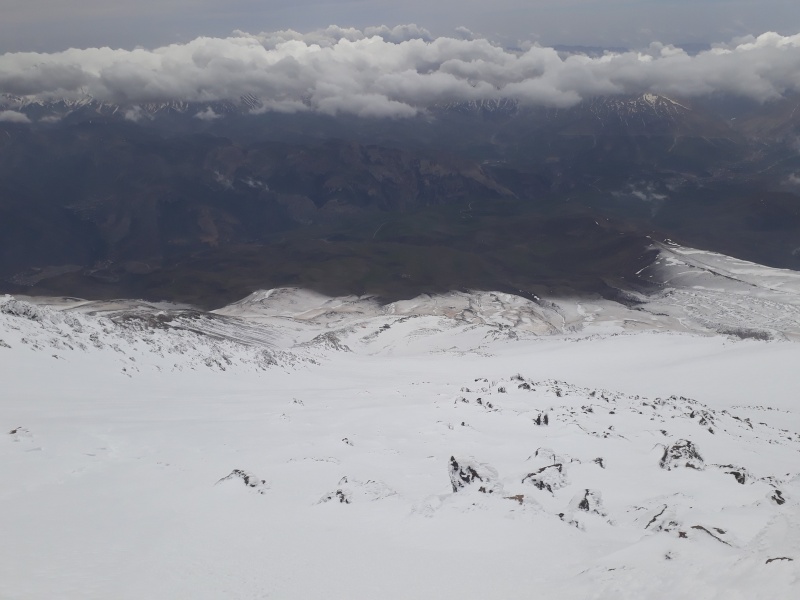 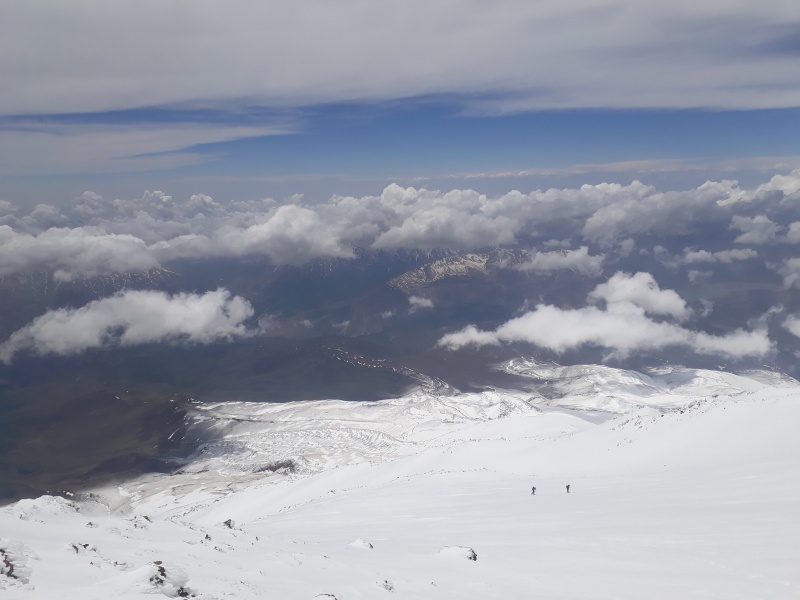 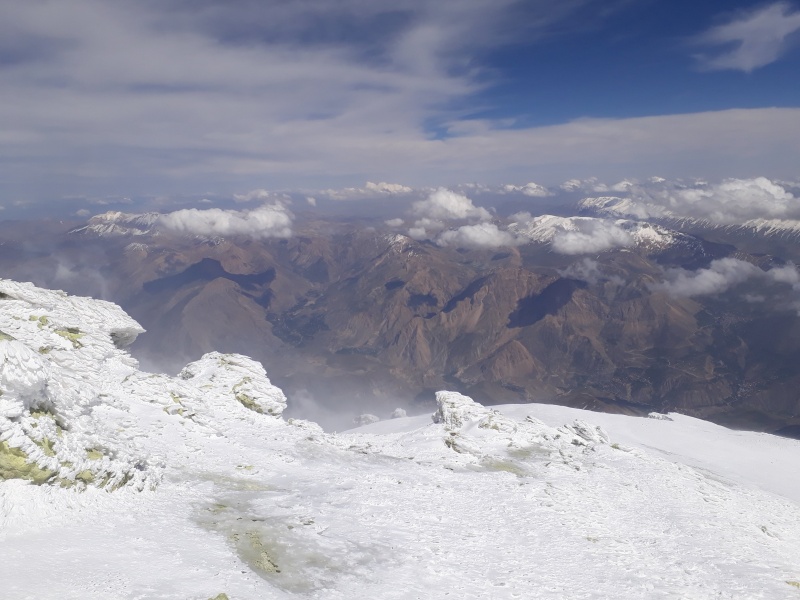 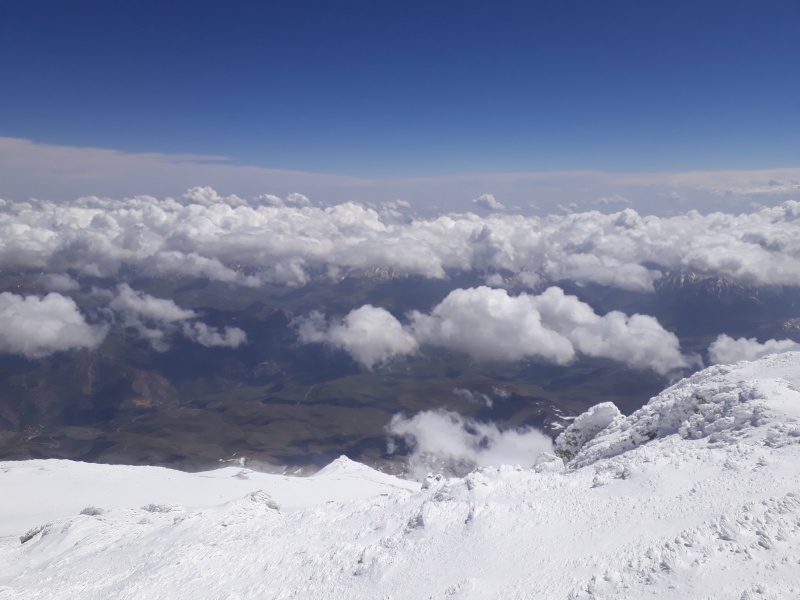 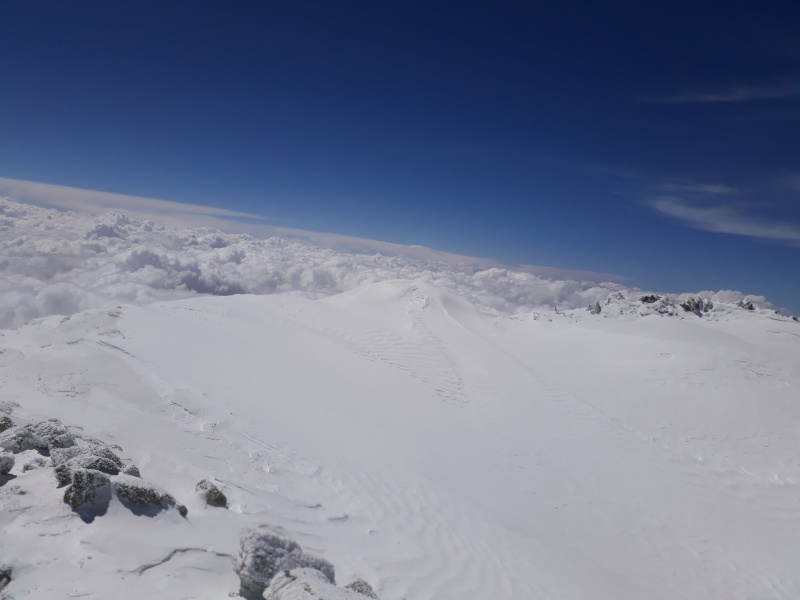 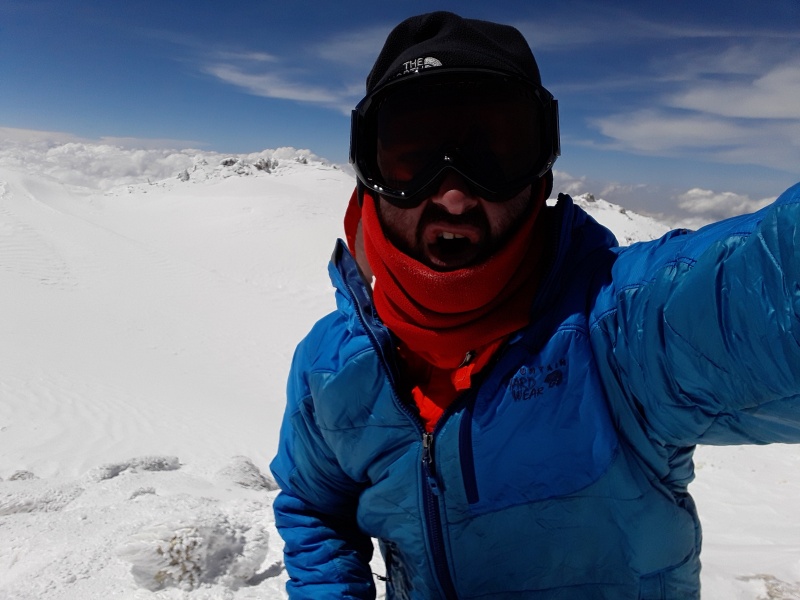 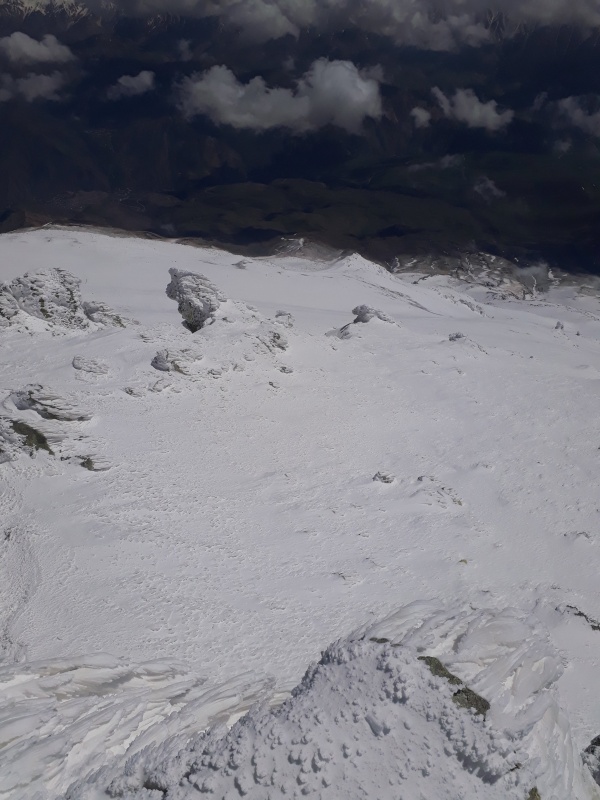 Above the shoulder the slope eased off considerably, but you are very exposed and high up at this point. From about 17,250 feet to 18,000 I was feeling winded, but it was manageable. After passing 18,000 feet I started to become slightly delirious and my progress slowed considerably, but I could see the summit quite close and this gave me the drive to fight the last 400 feet to the top. The last 200 feet to the top involved wandering in between fumaroles exhausting plumes of sulfur gas, the ice melted away above their openings. Once in a while I’d get a whiff of sulfur, but the wind would quickly carry away any residual plumes. I reached the spacious flat area beneath the summit blocks at 2:45 PM, collapsed and huddled out of the wind for an agonizing minute, letting a moment of nausea and screaming barfies pass before I bouldered the actual highpoint, took some photos, and immediately started down. I would have liked to take the time to explore the crater, but the conditions were not optimal, and I was really feeling like shit. I met the Austrians at the shoulder and gave them some encouragement, pointing out the final stretch to the top. Instead of descending the ridge I came up, I decided to run down the entire snowslope. The top of the slope which I thought had appeared much more steep from below turned out to only be about 35 degrees maybe. As I reached the slightly less steep section, I glissaded the rest of the way to the initial mellow section near the hut. I returned to the hut at 4:20, 1.5 hours after leaving the summit, and 6 hours and 45 minutes total roundtrip time. Some more Iranian climbers were just arriving from the lower mountain, and we introduced each other and they gave me coffee and snacks. An hour later we all watched the Austrians make their turns for 4000 consistent feet of good snow. 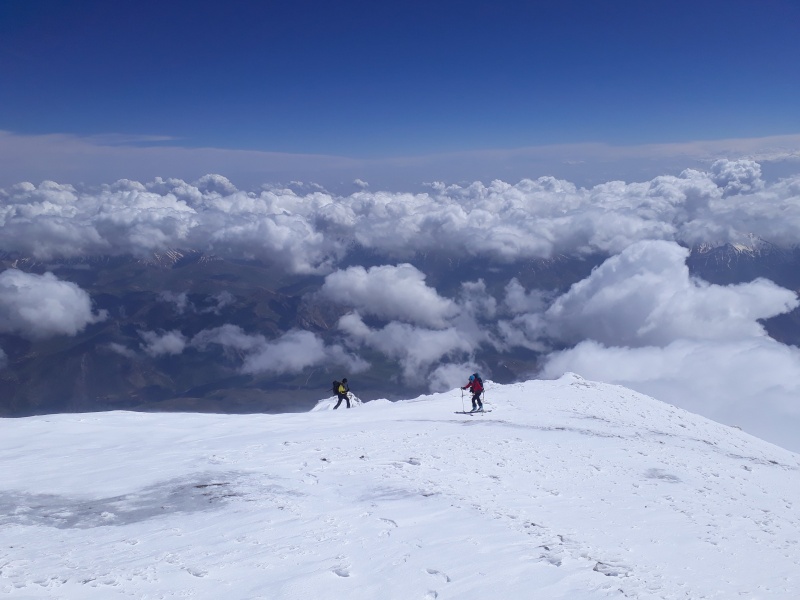 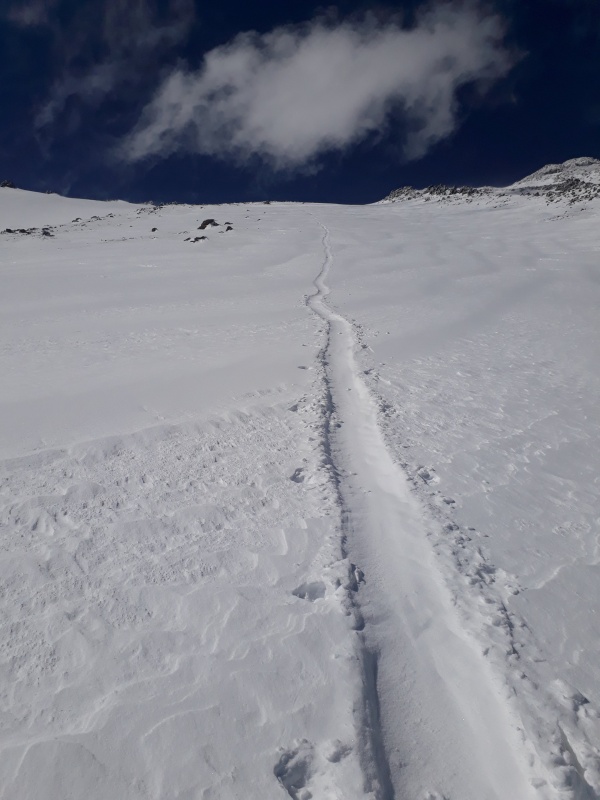 After the Austrians departure down the mountain, me and perhaps 7 Iranians, only a couple of which spoke very basic English, spent an enjoyable evening in the hut sharing stories and photos from each other’s previous outdoor adventures. Some things I left lost in translation: one guy was adamant that the Kalahari Desert was in USA; another guy showed me the classic photo of Edmund Hillary and Tenzing Norgay on Everest and tried to convince me that it was Reinhold Messner in the photo. Each one of them refused to let me go to sleep unless I had tried some of their food, so I ended up eating about 5 dinner’s worth of food (I could justify that by the amount of calories I had burned that day).  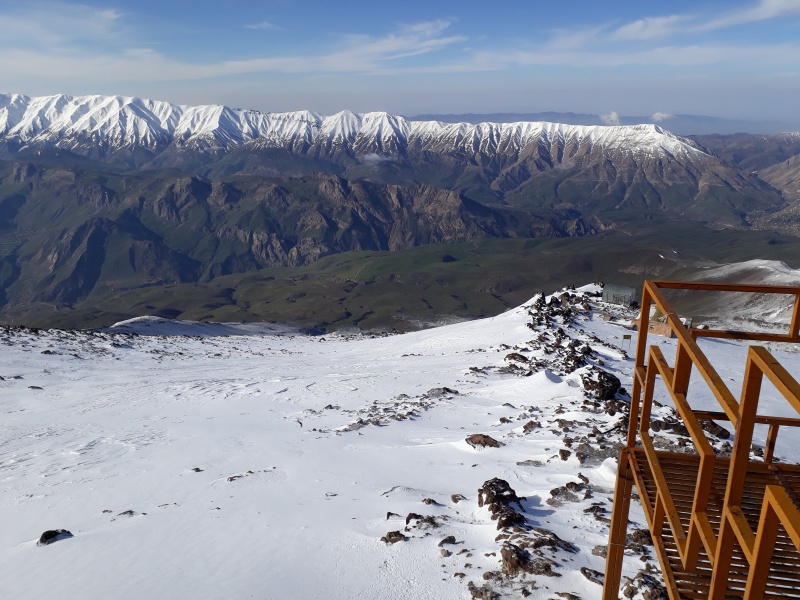 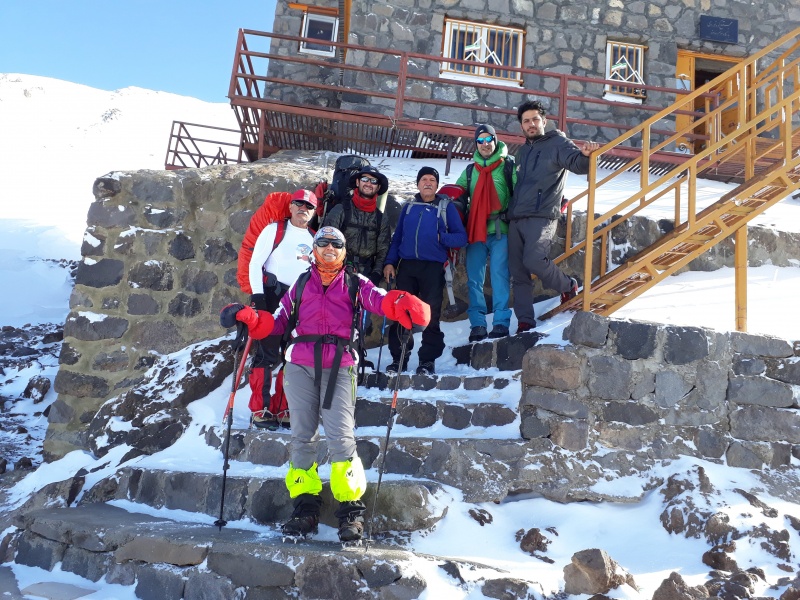 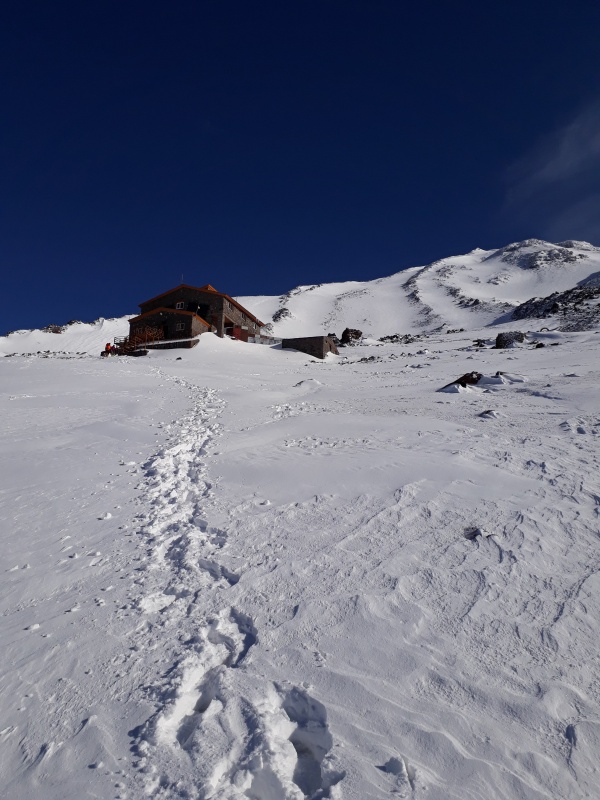  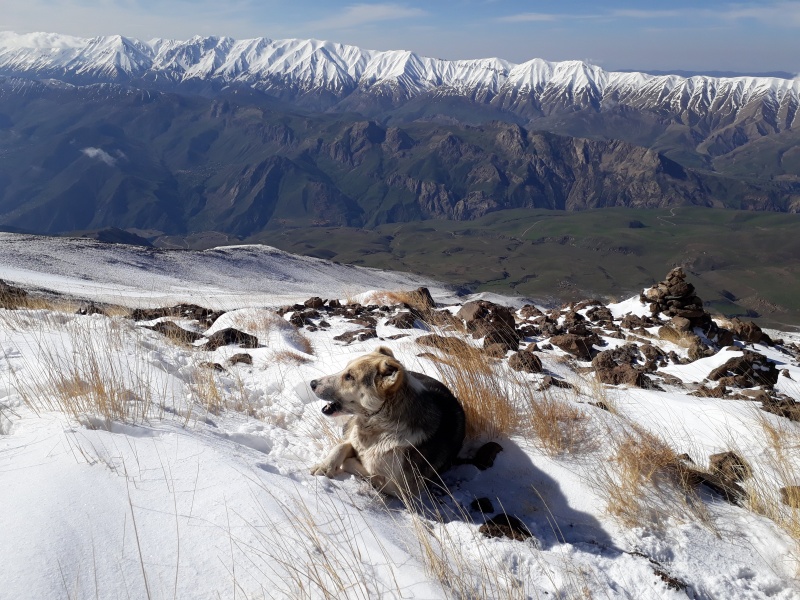 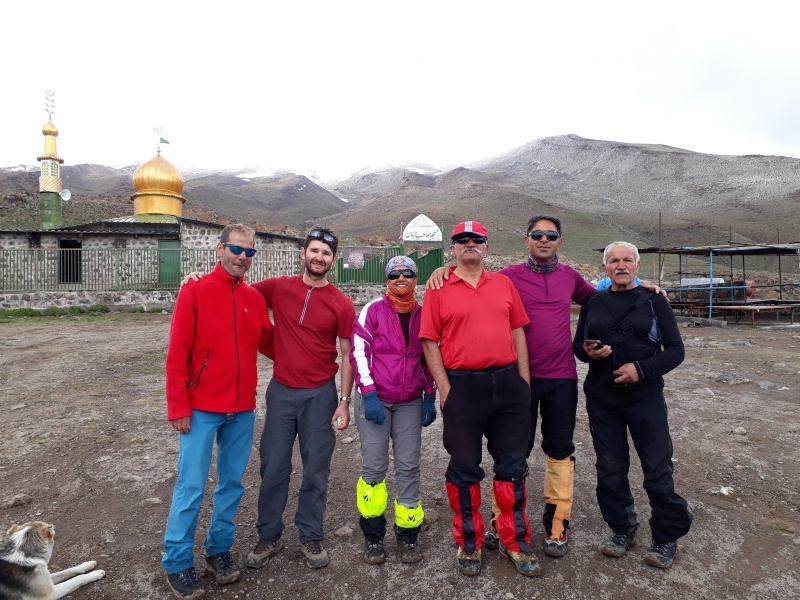 Only a couple of the Iranians started up the mountain on Friday morning, despite the improvement in weather. The bulk of the Iranians were content to hike back down with me, and even drive me back to Tehran. As a group we all hiked back down to the mosque in about 3 hours, this time through snow where there had been none when I came up 2 days previously. They had already arranged for one of the 4wd vehicles to pick us up and we all bounced down the road back to the paved road ($2.5). 2 hours later, they were dropping me off in the outskirts of Tehran, where they set me up with a taxi ($1.25) to the metro station, where I made my way back to my hostel. The remainder of Friday and Saturday I spent sightseeing in Tehran, wandering around, people-watching, and hanging out with other travelers at the hostel. Highlights included the Azadi Tower, Grand Bazaar (where you can definitely find everything you need for a trip up Damavand), the Islamic Museum, and the continuous thought that I could be thrown in jail if I was wearing shorts. Overall, a very enjoyable trip to the highest point in Iran. One last note; personally I think Damavand would be much more enjoyable in the conditions that I did them in rather than during the summer. I heard from the locals that on busy holidays during the summer, the mountain is absolutely packed, with hundreds of tents pitched alongside the hut, which has room for about 100 climbers in itself. So not only would the mountain be uncomfortably crowded, the route would involve a monotonous slog up volcanic scree. No thank you. Spring was very enjoyable and I found it to be an entertaining, mellow snow climb. There are plenty of other routes on the mountain if you want to get away from the crowds, but even these can be packed during the summer. Food for thought. Thanks for reading! 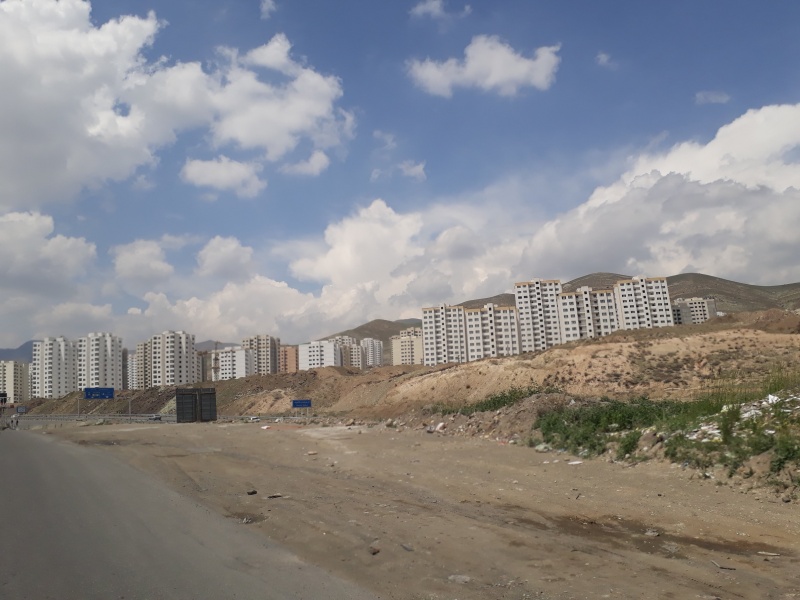 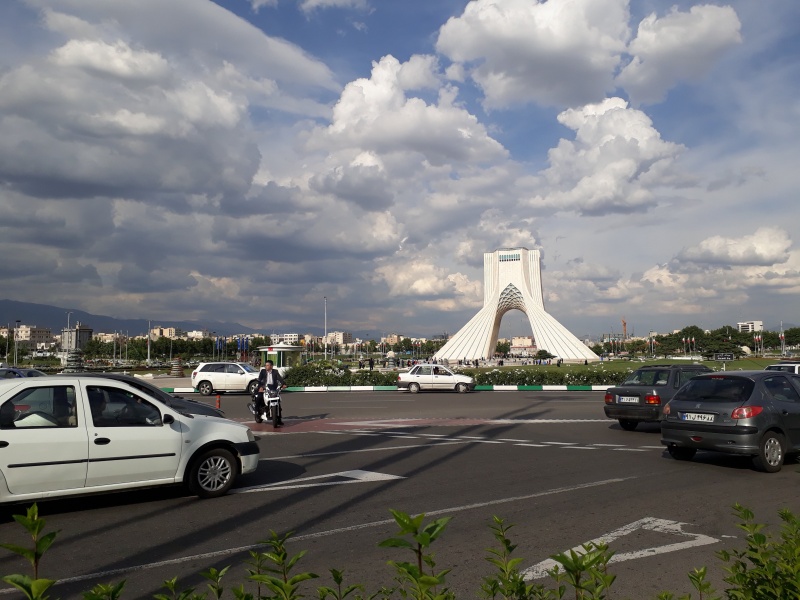 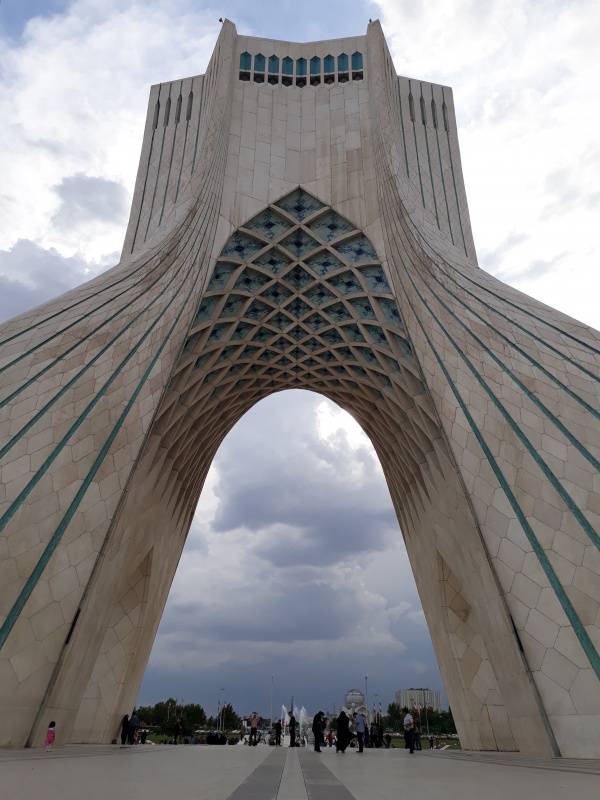 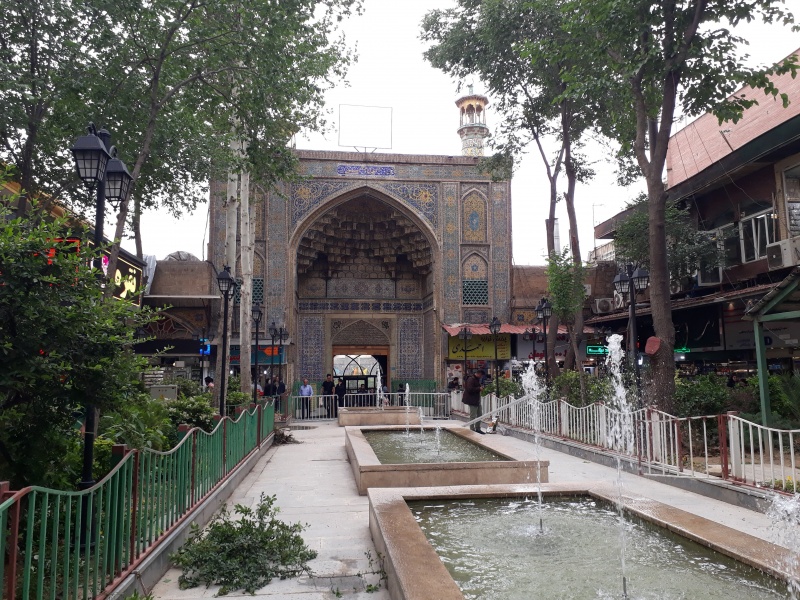 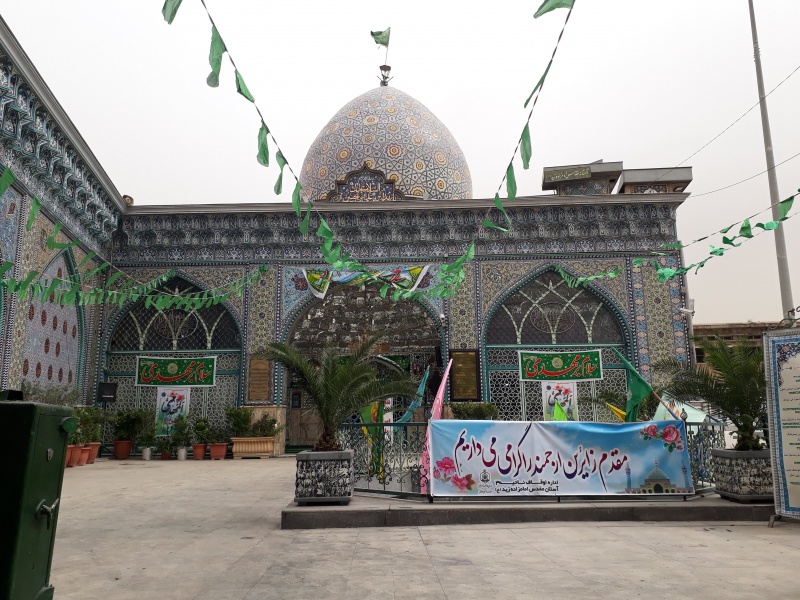 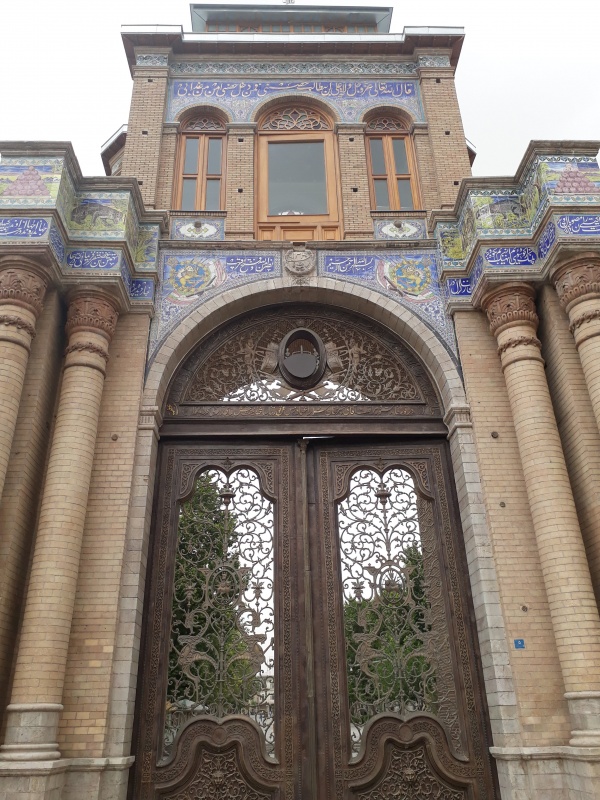 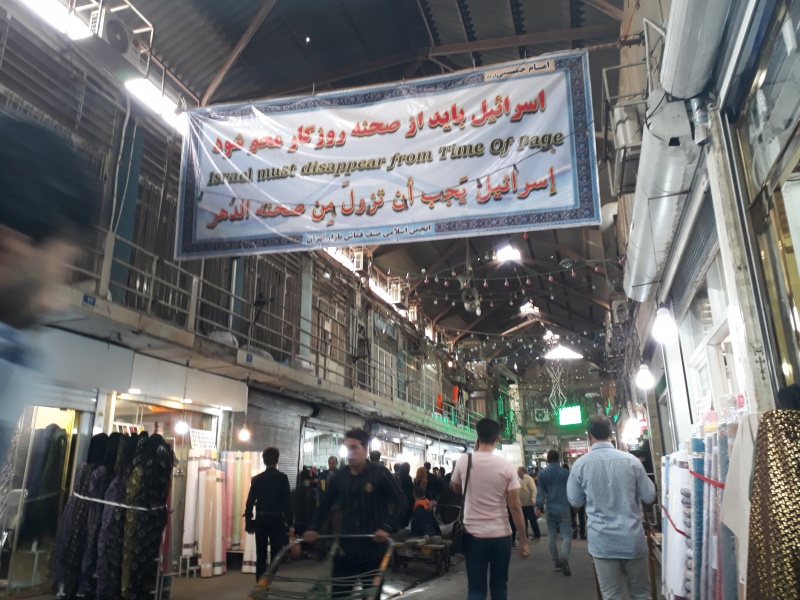 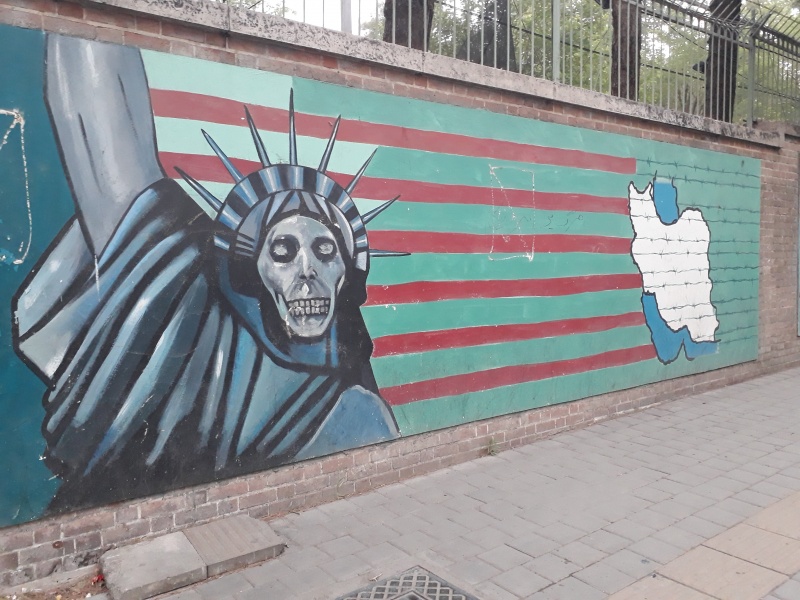 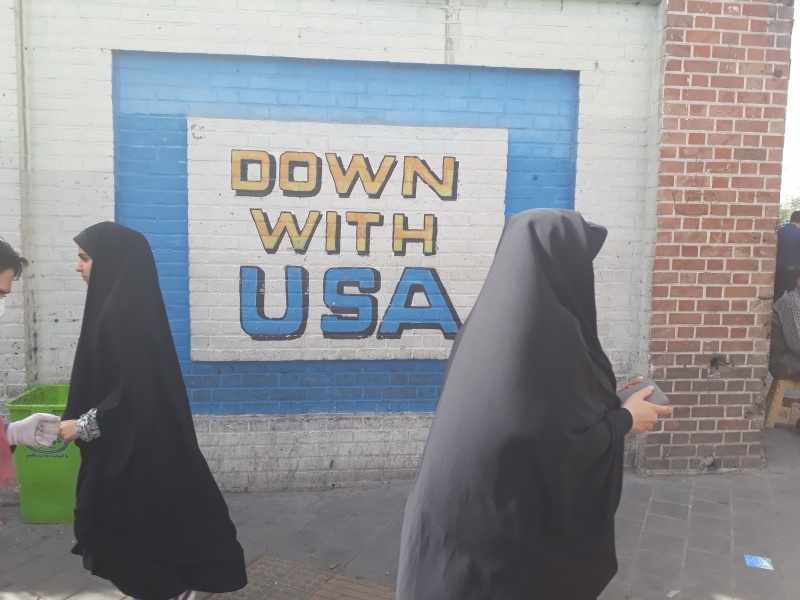 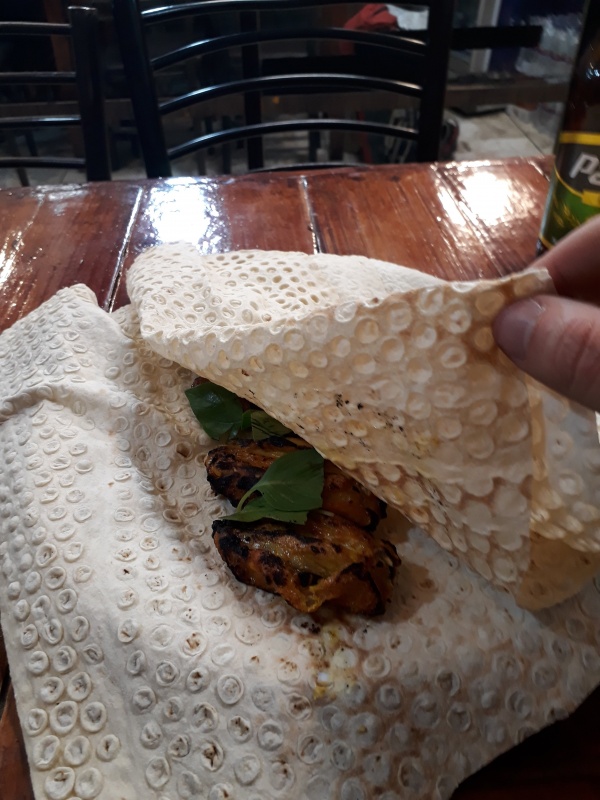 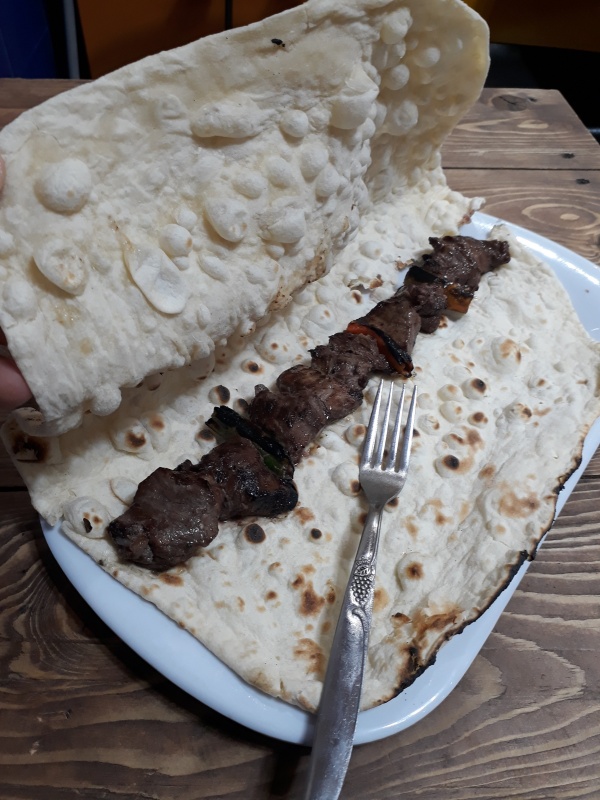 |
| Comments or Questions | ||||||||||||||||||
|---|---|---|---|---|---|---|---|---|---|---|---|---|---|---|---|---|---|---|
|
Caution: The information contained in this report may not be accurate and should not be the only resource used in preparation for your climb. Failure to have the necessary experience, physical conditioning, supplies or equipment can result in injury or death. 14ers.com and the author(s) of this report provide no warranties, either express or implied, that the information provided is accurate or reliable. By using the information provided, you agree to indemnify and hold harmless 14ers.com and the report author(s) with respect to any claims and demands against them, including any attorney fees and expenses. Please read the 14ers.com Safety and Disclaimer pages for more information.
Please respect private property: 14ers.com supports the rights of private landowners to determine how and by whom their land will be used. In Colorado, it is your responsibility to determine if land is private and to obtain the appropriate permission before entering the property.
